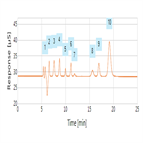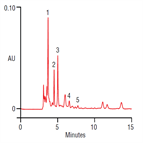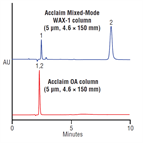Find methods for your needs
Refine by Feature
Displaying 1-4 of 4 results for Tag: Tartaric acid
Dionex IonPac ICE AS6 Column Performance Test Using its QAR Method
Instrument Type: ICBefore running any samples, Thermo Scientific recommends that you first confirm the performance of the column by reproducing the lot validation report chromatogram shipped with column.Compare your results with the one reported in the quality assurance report. At least three injections should be made. This record provides an eWorkflow for executing the QAR method on an ICS-5000 system.<enter final 90 characters of description>
Fast analysis of organic acids in white wine on a Thermo Scientific Acclaim Organic Acid (OA) column
Instrument Type: HPLCThe Thermo Scientific HPLC system is applied for the analysis of organic acids in white wine. The separation is performed on a Thermo Scientific Acclaim Organic Acid (OA) column, with UV detection at 210 nm. The samples were prepared using Thermo Scientific Dionex OnGuard II P SPE cartridges.
Comparison of the separation of tartaric and quinic acids on a Thermo Scientific Acclaim Mixed-Mode WAX-1 column vs a Thermo Scientific Acclaim Organic Acid column
Instrument Type: HPLCThe Thermo Scientific HPLC system is applied for the analysis of tartaric and quinic acids. The separation achieved on a Thermo Scientific Acclaim Mixed-Mode WAX-1 column is compared to the separation achieved on a Thermo Scientific Acclaim Organic Acid column. The unique chemistry of the Thermo Scientific Acclaim Mixed-Mode WAX-1 column cleanly separates these compounds based on different ionizations.
AN243: Determination of Common Anions and Organic Acids Using Ion Chromatography-Mass Spectrometry
Instrument Type: ICMSThis application note demonstrates the use of the IC-MS method for the determination of five common anions and three organic acids at parts per billion levels. With the use of very specific MS SIM detection, ppb level quantification can be performed with greater confidence on real world samples, such as bottled drinking water. The quantification results from MS were without prior sample preparation or employing preconcentration, which may be required with other detection methods.




